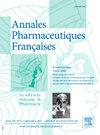Antimalarial evaluation of selected medicinal plants traditionally used for treatment of fever, by inhibition test of heme polymerization
IF 1.1
Q4 PHARMACOLOGY & PHARMACY
引用次数: 0
Abstract
Objectives
World Health Organization (WHO) has reported 249 million cases infected by malaria worldwide and 608 thousands deaths in 2022. Investigations for new antimalarial drugs from traditional medicine have proven to be more effective and less expensive. The medicinal plants that have been used for treatment of malaria, generally known as types of fevers in traditional medicine, can be suitable candidates for evaluating antimalarial effects. The aim of the present study was to evaluate the in vitro mechanism of antimalarial action of selected medicinal plants by inhibition test of heme detoxification (ITHD).
Material and methods
The methanol extract and fractions were prepared through maceration of the dry powdered plants. The ITHD method was carried in 96-wells plate and the percentage of heme polymerization inhibition was determined. The cytotoxicity of the effective plants was examined on MDBK cell line by MTT assay. Bioassay guided fractionation was performed exposing to size exclusion column chromatography and liquid-liquid fractionation and was assayed by the ITHD method for the sample with the least IC50 value and lowest cytotoxic effect.
Results
The methanol fraction of Viola odorata whole plant showed the most considerable results among the tested plants with IC50 171.8 μg.mL−1 beside the lowest cytotoxic effects. This fraction by the bioassay guided fractionation led to fraction SB2 and this fraction demonstrated the most effective result with lowest IC50 = 14.8 ± 3 μg.mL−1 in ITHD assay.
Conclusion
Regarding the results of the present study and the traditional use of V. odorata for overcoming fever in Iranian traditional medicine, the final fraction of the plant could be proper candidate for further phytochemical and antimalarial studies.
Objectifs
L’Organisation mondiale de la santé (OMS) a documenté 249 millions de cas de paludisme et 608 000 décès dans le monde en 2022. La recherche sur de nouveaux agents antimalariques dérivés de la médecine traditionnelle a montré des promesses en raison de leur efficacité potentielle et de leur coût réduit. Cette étude a cherché à investiguer les propriétés antimalariques de certaines plantes médicinales traditionnellement utilisées pour traiter la fièvre, en se concentrant sur leur capacité à inhiber la détoxification de l’hème.
Matériaux et méthodes
Des extraits de méthanol et des fractions ont été préparés à partir de matériel végétal sec et en poudre en utilisant la macération. Le test d’inhibition de la détoxification de l’hème (ITHD) a été réalisé dans une plaque à 96 puits pour déterminer le pourcentage d’inhibition de la polymérisation de l’hème. La cytotoxicité des plantes actives a été évaluée sur la lignée cellulaire MDBK en utilisant l’essai MTT. La fractionnation guidée par le bioessai a été réalisée par chromatographie en colonne d’exclusion de taille et fractionnement liquide-liquide, suivie d’un test ITHD sur l’échantillon avec la valeur IC50 la plus faible et une cytotoxicité minimale.
Résultats
Parmi les plantes testées, la fraction de méthanol de la plante entière de Viola odorata a présenté les résultats les plus significatifs avec IC50 171,8 μg.mL−1 à côté les effets cytotoxiques les moins importants. Une fractionnation guidée par le bioessai plus poussée de cet extrait a donné la fraction SB2, qui s’est avérée être la plus avec la plus faible IC50 = 14,8 ± 3 μg.mL−1 puissante dans l’essai ITHD.
Conclusion
Les résultats de cette étude, combinés à l’utilisation historique de Viola odorata dans la médecine traditionnelle iranienne pour le soulagement de la fièvre, suggèrent que la fraction finale de cette plante est un candidat approprié pour une analyse phytochimique supplémentaire et des recherches antimalariques.
通过血红素聚合抑制试验,对传统上用于治疗发烧的某些药用植物进行抗疟疾评估。
目标:世界卫生组织(WHO)报告称,2022 年全球疟疾感染病例将达到 2.49 亿例,死亡人数将达到 60.8 万。研究证明,从传统医药中提取新的抗疟疾药物更有效、成本更低。用于治疗疟疾的药用植物(在传统医学中一般被称为发烧类型)可作为评估抗疟效果的合适候选药物。本研究的目的是通过血红素解毒抑制试验(ITHD)评估所选药用植物的体外抗疟作用机制:材料和方法:通过浸泡干粉植物制备甲醇提取物和馏分。在 96 孔板中进行血红素脱毒抑制试验,测定血红素聚合抑制率。通过 MTT 法检测有效植物对 MDBK 细胞系的细胞毒性。生物测定指导下的分馏是通过尺寸排阻柱层析和液-液分馏进行的,并采用 ITHD 法检测 IC50 值最小、细胞毒性作用最低的样品:结果:在所测试的植物中,Viola odorata 全株的甲醇馏分显示出最显著的结果,其 IC50 值为 171.8 μg.mL-1,细胞毒性效果最低。通过生物测定引导分馏,得到了馏分 SB2,该馏分在 ITHD 试验中的 IC50 = 14.8 ± 3µg.mL-1 最低,显示出最有效的结果:根据本研究的结果以及伊朗传统医学中使用 V. odorata 来治疗发烧的传统,该植物的最终馏分可作为进一步植物化学和抗疟疾研究的适当候选成分。
本文章由计算机程序翻译,如有差异,请以英文原文为准。
求助全文
约1分钟内获得全文
求助全文
来源期刊

Annales pharmaceutiques francaises
PHARMACOLOGY & PHARMACY-
CiteScore
1.70
自引率
7.70%
发文量
98
期刊介绍:
This journal proposes a scientific information validated and indexed to be informed about the last research works in all the domains interesting the pharmacy. The original works, general reviews, the focusing, the brief notes, subjected by the best academics and the professionals, propose a synthetic approach of the last progress accomplished in the concerned sectors. The thematic Sessions and the – life of the Academy – resume the communications which, presented in front of the national Academy of pharmacy, are in the heart of the current events.
 求助内容:
求助内容: 应助结果提醒方式:
应助结果提醒方式:


